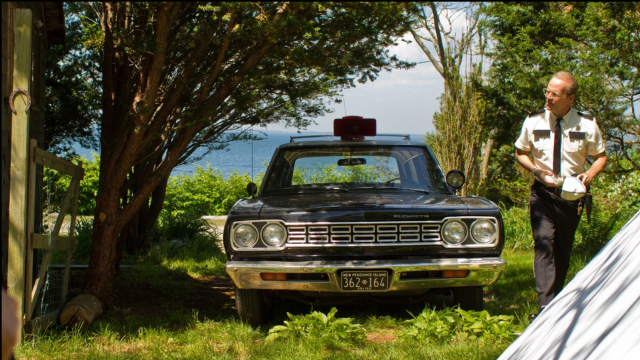Wes Anderson has been working hard to make sure the cars in his upcoming film The French Dispatch exude just the right kind of quirky Gallic flair. It’s hard work to get the cars in a film just right, but Anderson knows it pays off when he does. Just look at Bruce Willis’s Plymouth in Moonrise Kingdom.
In case you don’t remember, Moonrise Kingdom was Anderson’s 2012 picture about Sam Shakusky, a parentless scout on the lam from summer camp on a New England island with his pen-pal Suzy Bishop, doing his best to avoid getting dragged off by Social Services to a new life in an orphanage. It’s a mushy gushy one, to be sure, but it’s also stuffed with the kind of aesthetic and thematic detail that Anderson has long been known for, and that extends to the cars too. Well, one of them, at least. It does take place on an island, after all.
That particular car is a 1968 Plymouth Satellite station wagon police car driven by Captain Sharp, Bruce Willis’s policeman with a paternal streak. Though the model is anachronistic for the film’s 1965 setting, it’s exactly the right car for the role because it tells us more about Willis’s character than any normal police car might.
What am I getting at? That long roof, of course. Before minivans (and eventually crossovers) became the rides of choice for parents, there was only one body-style that could communicate familial warmth and practicality from a first glance: The full-size station wagon. Remember National Lampoon’s Vacation? No, not the remake. The original. The Griswolds’ Family Truckster took the station wagon trope to the malaise-era extreme.
And though station wagons have long served in police roles in real life, more commonly in Europe but also here in the States, it seems to me like a conscious choice on Anderson’s part to put Willis’s Captain Sharp in the Plymouth.
Sharp’s character arc finds him saving Sam from peril at the hands of the Hurricane gripping the island and becoming his legal guardian too. Though he was a cop, he was meant to be a parent. With a car to suit, he was more than ready to take the role.
Of course, the policeman-turned-parent is a popular trope these days. Just look at Sheriff Hopper and Eleven in Stranger Things. But While Hopper does drive a pretty rad car, the two-door K5 Blazer he’s got isn’t quite the same as the Plymouth in Moonrise Kingdom. Sure, it’s a practical vehicle, especially when you’re breaking into secret government labs at the edge of town, but it’s not exactly a family car, is it? Not next to the Plymouth it’s not.
It shouldn’t be much of a surprise that Anderson put nearly as much thought into casting his character’s vehicles as he did into casting the characters themselves, though. From Eli Cash’s Austin Healey in The Royal Tenenbaums to his racing-themed short film Castello Cavalcanti to the trains in The Darjeeling Limited and The Grand Budapest Hotel, Anderson has long put considerable effort into the cars, trains, buses, boats, and submarines in his films.
Just check out this supercut from Jaume R. Lloret that shows how camera angles, scale modelling, and stop-motion turn vehicles from parts of the setting into an integral component of Anderson’s method of characterisation.
I’ve long been impressed by Anderson’s craft, even if I know it occasionally borders on self-parody and the limits of taste. Still, it’s hard to deny that Anderson has done something special with the cars and other vehicles in his films, Bruce Willis’s Plymouth wagon being just one of many.
Like Jason, I’m excited to see all the Citroëns, Peugeots, and Simcas in his next flick. I’m sure they’ll play an important role in defining the players and sympathies that make the movie tick there too.
